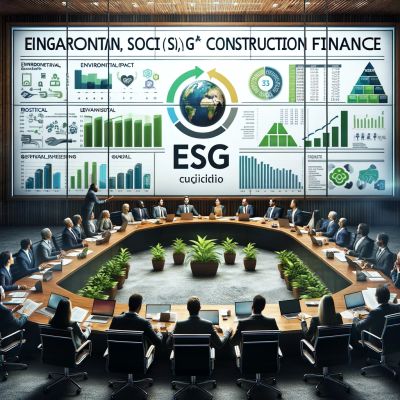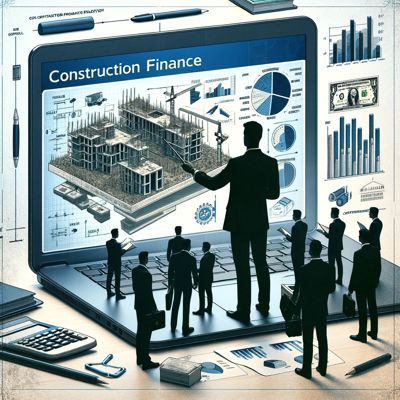
April is Construction Project Finance Month
April marks an exciting period as Highways.Today celebrates “Construction Project Finance Month”. This special month-long focus aims to shed light on the intricate financial aspects and strategies that underpin successful construction projects.
From exploring innovative funding models to delving into the challenges of budgeting and financial management, Construction Project Finance Month promises to offer invaluable insights.
Whether you’re a seasoned expert in the field or simply curious about how financial mechanisms drive the construction industry forward, there’s something for everyone to learn and discuss.
Join us as we navigate the complexities of construction finance, highlighting key trends, case studies, and expert opinions to enhance your understanding and appreciation of this crucial component of the construction world.

Construction Project Finance Sources
Leading global companies in Construction Project Finance often come from sectors such as banking, construction, and infrastructure development.
These entities are known for their financial strength, expertise in handling large-scale projects, and ability to navigate complex regulatory environments.
Here are some prominent players:

Banks and Financial Institutions
In the realm of Construction Project Finance, banks and financial institutions stand as pivotal enablers, offering the essential capital necessary for the realization of grand construction undertakings. Among the front-runners, J.P. Morgan Chase & Co., Bank of America Merrill Lynch, and Citigroup lead the pack, backed by their extensive global networks and deep financial resources. These institutions are complemented by HSBC and BNP Paribas, which bring international expertise to the table, especially in emerging markets. Wells Fargo rounds out this group, known for its strong focus on commercial lending, including significant allocations for construction and infrastructure projects. Together, these banks are instrumental in shaping the financial landscapes of construction projects around the globe, leveraging their vast experience and financial muscle to facilitate development across continents.

Infrastructure and Construction Companies
The construction and infrastructure domain is dominated by giants like Bechtel, Vinci, Larsen & Toubro (L&T), and China Communications Construction Company (CCCC), each carving out significant niches in the global market. Bechtel, revered for its engineering and construction expertise, has a storied history of completing complex projects across various sectors. Vinci, a French conglomerate, is not only a leader in construction but also in the management of public infrastructure, demonstrating a keen ability to innovate and expand. L&T, an Indian multinational, embodies the spirit of a diversified entity, excelling in technology, engineering, and financial services, which enables it to undertake projects of enormous scale. CCCC, a state-owned powerhouse from China, commands a significant presence in the construction of transportation infrastructure, showcasing China’s growing influence in global infrastructure development. These companies not only exemplify excellence in construction but also in navigating the intricate financial arrangements necessary to bring ambitious projects to life.

Private Markets
The global private markets is comprised of 10’s of 1,000’s of private debt/equity, hedge, alternative investment and other funds along with asset managers, family offices and an entire lexicon of entities allocating $trillions into projects worldwide. Often referred to by mainstream media as ‘shadow banking’, the private markets in terms of liquidity and flexibility now vastly overshadow the mainstream institutions. Their advantage is that they can lend against revenues from yet-to-be-built assets, from which mainstream institutions are precluded by their own regulations, except for the largest $multi-billion A+-rated transactions. Our project finance partner works directly with dozens of private markets lenders and will consider deal values from $100m to $10bn or more across hospitality, infra, healthcare and all other sectors.

Multilateral Development Banks (MDBs)
Multilateral Development Banks (MDBs) like The World Bank, The European Investment Bank (EIB), and Asian Development Bank (ADB) provide a unique blend of financial support and professional advice, which is indispensable for the development of infrastructure projects, especially in regions grappling with economic challenges. The World Bank, with its dual focus on poverty reduction and shared prosperity, offers both loans and grants, emphasizing capital projects that can transform communities. The EIB, as the European Union’s financial arm, specializes in financing sustainable investment projects that align with EU policy objectives, using its financial clout to drive innovation and development. ADB, focusing on the Asia-Pacific region, combines finance and knowledge to help its members achieve sustainable development, underscoring the critical role of regional development banks in global infrastructure finance.

Export Credit Agencies (ECAs)
Export Credit Agencies (ECAs) such as the Export-Import Bank of the United States (EXIM), UK Export Finance (UKEF), and Export Development Canada (EDC) represent national interests in the global trade arena. These agencies provide government-backed loans, guarantees, and insurance to domestic companies, facilitating the export of goods and services, including those related to construction and infrastructure projects. By mitigating risks associated with international trade and project financing, ECAs play a vital role in enabling companies from their respective countries to compete on the global stage, thereby ensuring that projects not only get off the ground but also contribute to the economic vitality and infrastructure development of nations worldwide.
The landscape of construction project finance is dynamic, with new players emerging as the market evolves. These organizations have a strong presence in various markets around the world and are key facilitators in the development of infrastructure projects.

Top 5 Construction Finance Articles

Unleashing Africa’s Renewable Energy Potential
Unleashing Africa's Renewable Energy Potential Africa stands on the brink of a renewable energy revo...
Read more Construction Finance News on Highways.Today here.

Current Trends in Construction Project Finance
In the dynamic landscape of Construction Project Finance, these current trends reflect a complex interplay of technological advancement, environmental consciousness, and evolving investment strategies.
As stakeholders navigate the challenges and opportunities of funding large-scale infrastructure projects, several key trends have emerged, shaping the way projects are financed, developed, and executed. These trends, driven by a mix of economic, technological, and societal forces, offer insights into the shifting priorities and innovative approaches within the industry.
From the growing emphasis on sustainability and green financing to the adoption of digital technologies and the strategic use of Public-Private Partnerships (PPPs), the current state of Construction Project Finance is marked by a pursuit of efficiency, resilience, and social impact. As the industry continues to adapt to these trends, the implications for future projects and investment strategies are profound, signaling a transformative period in the financing of global infrastructure development.

Sustainability and Green Financing
The shift towards sustainability has become a defining feature of construction project finance. Financial instruments like green bonds and sustainability-linked loans are increasingly popular, earmarking funds specifically for projects that promise environmental benefits. This trend is driven by a growing awareness of climate change and the urgent need for sustainable development. Investors, regulators, and the public are demanding that projects not only deliver financial returns but also contribute positively to the environment. As a result, projects such as renewable energy plants, eco-friendly buildings, and infrastructure promoting reduced carbon footprints are attracting significant investment. This emphasis on sustainability is reshaping the criteria for financing decisions, making environmental impact a key consideration alongside economic factors.

Public-Private Partnerships (PPPs)
Public-Private Partnerships have become a cornerstone in the development and financing of infrastructure projects around the world. This collaborative model leverages the efficiency, innovation, and capital of the private sector while aiming to fulfill public sector goals for infrastructure development. PPPs facilitate the delivery of essential services and infrastructure, from transportation networks to water treatment facilities, by combining the strengths of both sectors.
The trend towards PPPs reflects a pragmatic approach to overcoming budget constraints, sharing risks, and enhancing the quality of public infrastructure projects. As governments look to address their infrastructure gaps without overextending public finances, PPPs are likely to play an increasingly vital role in the future of project finance.

Digitalization and Technological Integration
The integration of digital technologies into construction project finance is transforming the landscape of the industry. Blockchain technology, for instance, is being explored for its potential to streamline payments, enhance transparency, and reduce fraud. Big data and analytics offer insights that can improve risk assessment, project management, and decision-making processes. These technologies are not only making financial transactions more secure and efficient but are also enabling more sophisticated financial models and strategies. The trend towards digitalization reflects a broader movement within the construction industry to embrace innovation, improve efficiency, and adapt to a rapidly changing technological environment.

Increased Focus on Social Infrastructure
There is a growing recognition of the importance of investing in social infrastructure, such as healthcare facilities, educational institutions, and affordable housing. This trend has been accelerated by the global COVID-19 pandemic, which highlighted the critical role that such infrastructure plays in societal well-being and resilience. Financing is increasingly directed towards projects that address social needs and contribute to the fabric of communities. This shift represents a broadening of the infrastructure finance landscape, where the value of projects is measured not only in economic terms but also in their impact on social outcomes.

Future Trends in Construction Project Finance
As the horizon of Construction Project Finance extends into the future, emerging trends forecast a transformative shift in how projects are conceptualized, funded, and realized. The confluence of technological innovation, heightened environmental and social awareness, and the evolving global economic landscape is poised to redefine the parameters of infrastructure development.
These future trends, from the rise of alternative financing models to the integration of Environmental, Social, and Governance (ESG) criteria, signify a departure from conventional practices towards more inclusive, sustainable, and adaptable financing solutions. Innovative construction methods and the impact of global economic shifts further underscore the necessity for flexibility and resilience in project finance structures. As these trends gain momentum, they promise to influence not only the economic viability of projects but also their potential to contribute to a more sustainable and equitable world. The future of Construction Project Finance is thus marked by a paradigm shift, with stakeholders at the cusp of navigating uncharted territories in infrastructure development and financing.

Rise of Alternative Financing Models
As the construction industry seeks more flexible and accessible financing solutions, alternative models like crowdfunding and peer-to-peer lending are gaining traction. These platforms democratize access to capital, allowing a wider range of investors to participate in infrastructure projects. This trend is particularly relevant for smaller, innovative, or community-oriented projects that may not fit traditional financing criteria.
The rise of alternative financing reflects a broader shift in the financial ecosystem towards more inclusive and diversified funding sources, offering new opportunities for both project developers and investors.

Integration of ESG Criteria
The integration of Environmental, Social, and Governance (ESG) criteria into investment decisions is set to reshape construction project finance profoundly. Investors are increasingly screening projects based on their ESG performance, prioritizing those that demonstrate environmental stewardship, social responsibility, and ethical governance.
This shift is driven by consumer demand, regulatory pressures, and a recognition of the long-term value that sustainable practices bring to projects. As ESG criteria become more embedded in financing decisions, projects will need to adapt to meet these standards, influencing design, execution, and operational practices.

Adoption of Innovative Construction Methods
The future of construction project finance will also be influenced by the adoption of innovative construction methods, such as modular and prefabricated construction. These approaches offer potential cost savings, efficiency gains, and environmental benefits compared to traditional construction methods. Financing models that accommodate the upfront investment and lifecycle costs of these innovative methods will become increasingly important. As the construction industry continues to innovate, project finance will need to evolve to support these advancements, ensuring that funding mechanisms are aligned with the changing nature of construction projects.

Impact of Global Economic Shifts
The construction project finance sector is inherently sensitive to global economic trends, including fluctuations in interest rates, inflation, and geopolitical events. These factors can significantly impact the cost of capital, the viability of projects, and investment strategies.
Future trends in project finance will need to account for these uncertainties, developing more resilient and flexible financing structures that can adapt to changing economic conditions. This adaptability will be crucial for managing risks and ensuring the successful delivery of projects in an unpredictable global landscape.

Regulatory Changes and Incentives
Governments play a pivotal role in shaping the project finance environment through regulatory frameworks and incentives. Future trends will likely see increased regulatory support for projects that align with governmental policy objectives,
The landscape of Construction Project Finance is undergoing a significant transformation, guided by current trends that emphasize sustainability, technological integration, and innovative financing models, and looking ahead to a future where ESG criteria, alternative financing, and global economic dynamics will play pivotal roles. These evolving trends encapsulate the industry’s response to the changing demands of society, the environment, and the economy, highlighting a shift towards more responsible, efficient, and adaptable financing and construction practices.
As we navigate through these changes, the ability of stakeholders to anticipate and adapt to these trends will be crucial in shaping the infrastructure that underpins global development. The journey through the current and future trends in Construction Project Finance is not just about adapting to change but about driving progress towards a more sustainable, inclusive, and resilient future.

Construction Project Finance Resources
When seeking information or guidance in the realm of global construction project finance, several key resources stand out for their depth of knowledge, industry insights, and practical advice.
Here’s an outline of top resources in this field:
- PwC’s Global Construction Survey: Offers insights into market trends, challenges, and opportunities in the global construction industry, including aspects of project finance.
- McKinsey & Company’s Insights: Provides research and reports on the construction industry, including innovations, financial modeling, and sustainability in project finance.
- The Construction Management Association of America (CMAA): Offers resources, training, and certifications for construction managers, including best practices in project finance.
- The International Project Finance Association (IPFA): A global network for professionals involved in project finance and public-private partnerships, offering events, training, and industry news.
- The World Bank: Provides extensive resources on project finance, particularly in emerging markets, including guidelines, case studies, and research papers.
- The European Investment Bank (EIB): Offers insights into project finance within the EU, including sustainable infrastructure and public-private partnerships.
- Global Infrastructure Forum: An annual event bringing together stakeholders from various sectors to discuss infrastructure development and financing.
- UK Finance: The organization provides guidance, research, and policy updates relevant to finance and banking, including areas pertinent to construction project finance such as real estate finance, SME lending, and infrastructure investment.
- Financial Conduct Authority (FCA) in the UK and Securities and Exchange Commission (SEC) in the US: Provide regulatory guidance and reports that impact project finance.
- Highways.Today: Our own platform is a great resource for articles, case studies and news on all matters to do with construction project finance.
These resources are valuable for professionals navigating the complex landscape of financing large-scale construction projects across the globe.

Construction Project Finance Education
In the ever-evolving world of construction project finance, education serves as the bedrock for professionals aiming to navigate this complex field successfully. As the industry faces new challenges and embraces innovative technologies and financing models, the demand for continuous learning and skill enhancement has never been greater. Construction finance project education encompasses a broad spectrum of knowledge areas, including financial modeling, risk management, legal frameworks, and sustainability considerations.
This educational journey empowers individuals with the insights and tools necessary to drive successful projects from conception to completion. Through a combination of academic programs, professional courses, and practical workshops, learners can acquire the expertise needed to make informed decisions, optimize financial structures, and contribute to the industry’s future.

Financing and Investing in Infrastructure
Università Bocconi
Learn how debt and equity can be used to finance infrastructure investments and how investors approach infrastructure investments!
According to the OECD, the global infrastructure investment requirement by 2030 for transport, electricity generation, transmission & distribution, and water & telecommunications totals to 71 trillion dollars. This figure represents about 3.5% of the annual World GDP from 2007 to 2030.
The European Commission estimated, that by 2020, Europe will need between 1.5 – 2 trillion Euros in infrastructure investments. Between 2011 and 2020, about 500 billion Euros will be required for the implementation of the Trans-European Transport Network (TEN-T) program, 400 billion Euros for Energy distribution networks and smart grids, 200 billion Euros on Energy transmission networks and storage, and 500 billion Euros for the upgrade and construction of new power plants. An additional 38 – 58 billion Euros and 181 – 268 billion Euros in capital investment will be needed to achieve the targets set by the European Commission for broadband diffusion.
Traditionally investments in infrastructure were financed using public sources. However, severe budget constraints and inefficient management of infrastructure by public entities have led to an increased involvement of private investors in the business.
The course focuses on how private investors approach infrastructure projects from the standpoint of equity, debt, and hybrid instruments.
The course concentrates on the practical aspects of project finance: the most frequently used financial techniques for infrastructure investments. The repeated use of real life examples and case studies will allow students to link the theoretical background to actual business practices.
In the end of the course, students will be capable of analyzing a complex transaction, identifying the key elements of a deal, and suggesting proper solutions for deal structuring from a financial advisor’s perspective.

Financing Infrastructure in African Cities
United Cities and Local Governments of Africa
The world is urbanizing fast. In less than a century more than 1 billion people have been urbanized. That translates into the fact that more than half of the world’s population is already living in cities. Experts forecast that very soon Africa will become one of the most urbanized continents. However, almost 70% of world’s urban population is living in the cities where governments are struggling to provide basic services like sanitation, schools, hospitals, and adequate clean water.
The reason is that, their governments do not have enough money. This may also be true also for the city where you live or work. Poor infrastructure affects your daily life. Local governments struggle with mobilizing finances so that they can improve your quality of life but many times they are not aware of the right mechanisms. Imagine that your government wants to know how can they finance cities and they want you to advise – where will you begin with? Our finance experts are bringing their experience right at your Desk through this online course.
This MOOC has five modules and in five weeks you will learn:
- Financial decision making environment in urban systems
- Mechanisms for mobilizing local revenues
- Innovative mechanisms for financing infrastructure projects through partnerships, and
- Financial decision making under uncertainties and risks
Join the online course and find out the ways to make your city a better place to live in for yourself and for your next generations. (This course was developed in collaboration with the United Cities and Local Governments of Africa (UCLG-Africa), African Local Governments Academy (ALGA), and Erasmus University Rotterdam).
gure represents about 3.5% of the annual World GDP from 2007 to 2030.
The European Commission estimated, that by 2020, Europe will need between 1.5 – 2 trillion Euros in infrastructure investments. Between 2011 and 2020, about 500 billion Euros will be required for the implementation of the Trans-European Transport Network (TEN-T) program, 400 billion Euros for Energy distribution networks and smart grids, 200 billion Euros on Energy transmission networks and storage, and 500 billion Euros for the upgrade and construction of new power plants. An additional 38 – 58 billion Euros and 181 – 268 billion Euros in capital investment will be needed to achieve the targets set by the European Commission for broadband diffusion.
Traditionally investments in infrastructure were financed using public sources. However, severe budget constraints and inefficient management of infrastructure by public entities have led to an increased involvement of private investors in the business.
The course focuses on how private investors approach infrastructure projects from the standpoint of equity, debt, and hybrid instruments.
The course concentrates on the practical aspects of project finance: the most frequently used financial techniques for infrastructure investments. The repeated use of real life examples and case studies will allow students to link the theoretical background to actual business practices.
In the end of the course, students will be capable of analyzing a complex transaction, identifying the key elements of a deal, and suggesting proper solutions for deal structuring from a financial advisor’s perspective.
The journey through construction finance project education is one of ongoing discovery and professional growth. As the landscape of the construction industry continues to transform, the knowledge and skills acquired through such education become invaluable assets for professionals. This educational path not only enhances individual careers but also elevates the entire field, leading to more innovative, sustainable, and financially viable construction projects.
Whether through formal academic programs, specialized training courses, or self-directed learning, the pursuit of education in construction project finance is a commitment to excellence and leadership in one of the world’s most vital industries. As we look ahead, the continuous advancement of educational offerings will remain a critical pillar supporting the development of professionals who are ready to meet the challenges and opportunities of the future.








